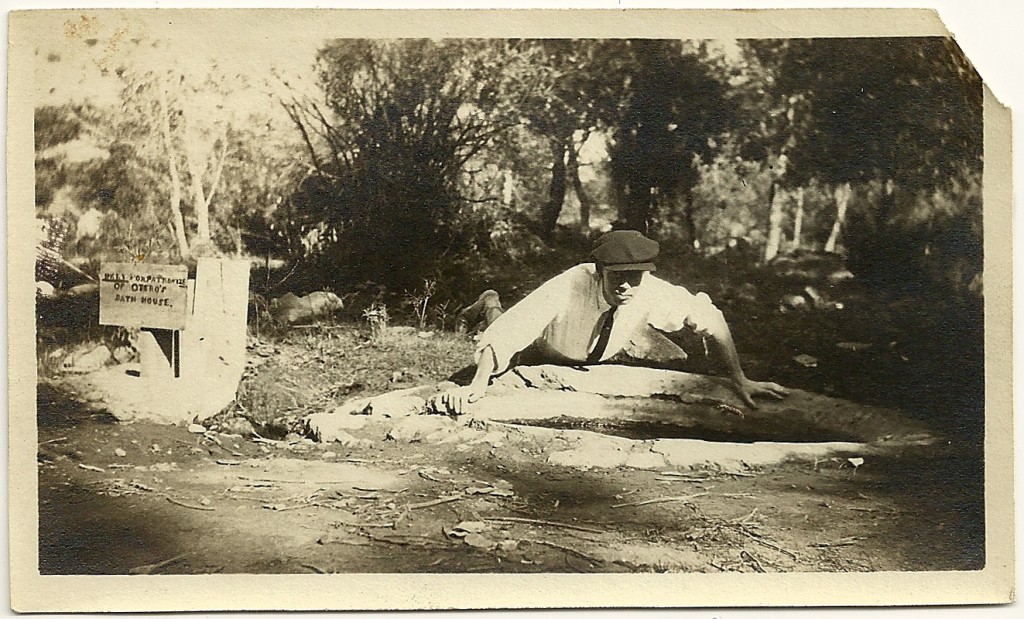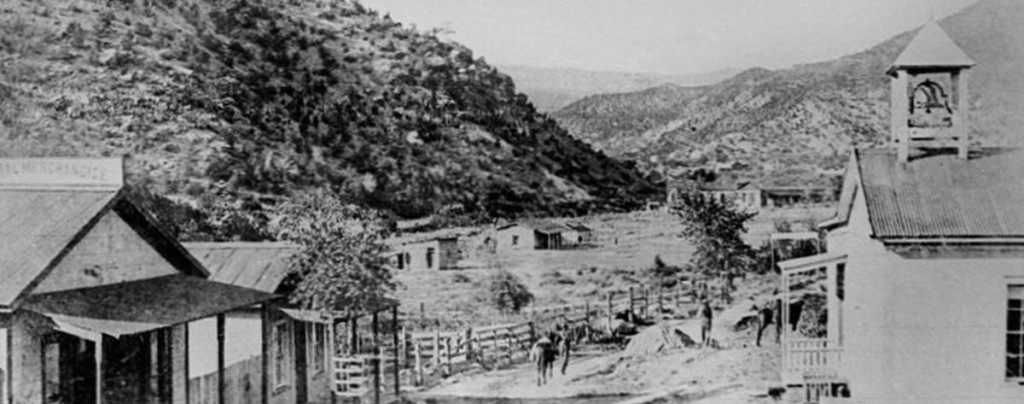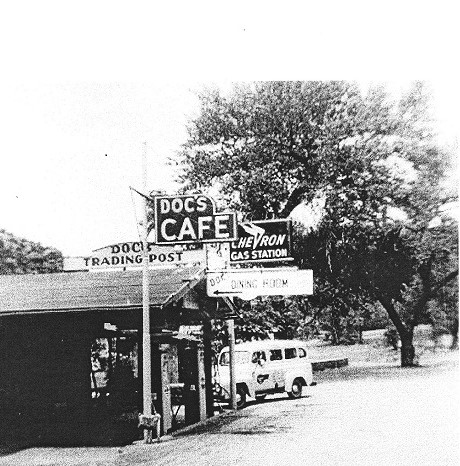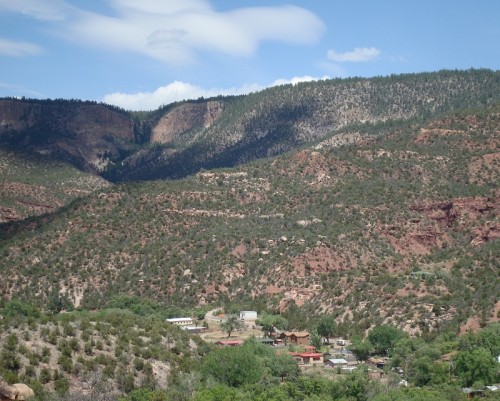
The first residential area in what is now Jemez Springs was the large pueblo of Guisewa, occupied until the late 1500s. One can easily assume that the Ancestral Puebloans chose the location primarily for the same reason that people come today: healing mineral hot springs next to a reliable water source, the Jemez River. The eastern section of the long-abandoned pueblo constitutes the Jemez Historic Site; the rest is buried under the modern construction of State Highway 4 and Via Coeli, built in 1947 as a Catholic retreat center.
The Spanish reconquered the Jemez people in 1694 after the Pueblo Revolt of 1680 drove them out, and slowly colonists returned to settle in the Cañon de San Diego. The story goes that around 1860, one of the hot springs erupted in a geyser, and someone who realized the commercial potential was around to see it. The resulting pool was enclosed with a rock wall, and subsequently a structure was built around it where the gazebo next to Jemez Springs Bath House is today. By 1881, a bath house and hotel had been built to accommodate travelers who came up the tortuous road, then called the Wagon Road, from Albuquerque to “take the waters.” Remnants of one of the early hotels can be seen on the north side of the Bodhi Mandala Zen Center property. An early bath house was also built by Moses Abousleman on what is now the Jemez Hot Springs property. That old building is still standing (sort of) on the banks of the river after it was closed following a disastrous flood in 1941.
An influential early landowner in Jemez Springs was Miguel Antonio Otero (1829-1882). He was head of a wealthy and politically powerful family in northern New Mexico that invested in vast amounts of property, as well as banking and merchandising. Otero was a great supporter of the Atchison, Topeka and Santa Fe Railroad and saw it connect to Las Vegas, NM, where he lived. He envisioned a big resort in Jemez Springs to be served by a branch of the ATSF up from Bernalillo.
By 1897, the Otero family owned a hot springs bath house, hotel, general merchandise store, and the Sulphur Hot Springs stage line, which brought travelers over the mountains from Santa Fe. His son, also named Miguel Antonio Otero, wrote in his memoir, My Life on the Frontier 1864-1882, that

Jemez Hot Springs are without a shadow of a doubt the greatest medicinal mineral hot springs in America. With railroad facilities and good hotel accommodations, these springs will advertise themselves, and eventually become the most celebrated curative mineral waters in the world. . . . For humanity’s sake, these springs should be purchased from the present owners by the Government, together with the Sulphur Springs and the Baca Location No. 1 [both of which Otero also owned] and made into one of the greatest health resorts in the world . . .
The elder Otero died before these plans could be completed. The younger Otero did not pursue the project but later became, among other things, the 16th governor of New Mexico.
In 1888, the first U.S. post office was opened with the name of Archuleta, one of the original recipients of the San Diego Land Grant. J. B. Block also operated a hotel and a stage line to Albuquerque. At some point, the Perea family, prominent pioneers in Bernalillo and San Ysidro, joined with the Oteros in running the bath house. In 1894, the post office was renamed Perea.
Another influential family was that of Moses (or Moises) Abousleman, a Lebanese immigrant who first operated a trading post at Jemez Pueblo. He and his family moved to Jemez Springs in 1912 and operated a bath house and mercantile.
A document from 1906 titled Deeds Issued in Jemez Springs by Jemez Land Company lists 42 deeds issued to individuals for lots in what was soon to be Jemez Springs. Included among them are Moses Abousleman, John W. Miller, J. N. Shields, Jessie Fenton, Anna Block, Charles H. Clay, and members of the Otero family. In 1907, the post office received the name it bears today: Jemez Springs.
In 1921, a team from the Museum of New Mexico journeyed to what many continued to call Jemez Hot Springs, a trip which took six hours from Santa Fe. An article in El Palacio, Aug. 15, 1921, describes Jemez Springs as follows:
[t]he little town of Hot Springs [which] lies sprawling on the steep banks of the north fork of the river which is known as the San Diego while the south fork is the Guadalupe Canon, which is still more precipitous and abounds with water and rapids. The springs which gave the name to the settlement are in private ownership and marvelous tales are told of the efficacy of the water as well as of the mud baths. Little farms that were lush green after the rains that came in June shimmer in the sun like emeralds set with rubies.
Throughout the first half of the 20th century, the village developed services and infrastructure, albeit somewhat lagging behind the rest of the world. In 1947, the electric coop was formed to expand coverage from just a few buildings served by an old power plant. The road to Jemez Springs was paved in 1949. The Village became incorporated in 1955, primarily so a public high school could be built in the valley and secondary students wouldn’t have to be bused to Bernalillo. The first telephone in the area was installed in the Abousleman house in 1965. A community library was started that same year in the lobby of the Presbyterian Church.
Encouraged by these improvements, tourism increased as people were drawn here, as they had been for more than 100 years, by the healing waters, excellent fishing and hunting, and beautiful scenery. Businesses turned from supplying the local farmers and loggers to serving the increasing numbers of visitors. Many of the tourist-oriented businesses in the village today are operating in historic structures, buildings that are more than 100 years old. Among them are Los Ojos Bar and Grill, Jemez Mountain Views, Jemez Mountain Inn, Jemez Stage Stop, Abousleman home, Casa Blanca, and Jemez Springs Bath House.
Other businesses in Jemez Springs have a less lengthy history. For example, at one time the village had two gas stations. One set of pumps was at what is now Jemez Stage Stop. The other was at what is now Jemez Fine Arts Cooperative. That building has previously housed another art gallery, little theater, and two gift shops. What was once a youth hostel now houses Weekends, a gift shop. Adjacent is the Jemez Canyon Inn owners’ residence, which once served as the infirmary for priests from the Servants of the Paraclete. The coffee shop has been a trading post and previous bakery. The brick building housing Jemez Artisans Cooperative Gallery was the post office from early 1960s to 1997, when a new post office opened.
In addition to a worldwide reputation for its healing mineral springs, Jemez Springs gained recognition, and sometimes notoriety, as an ecumenical religious center. In addition to the historic Presbyterian and Catholic churches, the village has been home to two Catholic religious orders, Servants of the Paraclete and Handmaids of the Precious Blood, and the Bodhi Mandala Zen Center.
A great honor was bestowed on Jemez Springs in 1995 when it received the All-American City Award from the National Civic League, one of the smallest municipalities in the nation to be so honored. The Jemez Thunder put out an eight-page special supplement in honor of the occasion Then-mayor David Sanchez was one of four Village residents to make a presentation to the Award jury. He concluded his remarks to the jury by stating:
For hundreds of years and even today, there still exist cultural barriers which must be studied and taken down. Jemez Springs has become a community that is planning for the future rather than reacting to the issues. The problem-solving process is working, and there is a dialog among its diverse populations rather than a monologue. For this ability to recognize their weaknesses, seek solutions and produce quantifiable results, I would ask for your consideration of Jemez Springs and all of the small communities across the country. (Jemez Thunder Supplement, August 1995.)
In the decades since Mayor Sanchez made this speech, we have seen changes in elected officials, seen businesses change hands or close, seen the old American Legion burn down and a new Catholic fellowship hall in its place, seen the old firehouse become a brewpub and a new fire station constructed on Bombero Drive, seen a dramatically expanded public library, seen a skateboard park take over the old tennis court in the Village plaza, and much more. In other words, the wheel keeps turning, and underneath it all Jemez Springs is a small village on the banks of a river underneath ancient cottonwoods graced with healing waters and surrounded by breath-taking views.





